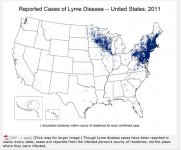It's unbelievable that this disease can be so debilitating, and life-threatening, and that more is not known, nor anything done to try to eradicate it.
Scott, plenty is known about Lyme, but little is being done about it. To get an idea of the extent of the cluster f*ck known as "Lyme research", read "Cure Unknown", by Pamela Weintraub. Pam is a professional science writer who lived in Westchester Co, NY. She and her entire family went through repeated attacks of Lyme while living there, getting and staying sick for years despite long-term treatments with mega doses of numerous antibiotics.
Pulling no punches, and using her professional contacts to gain access to info that is not being shared publicly, she went deep into the heart of the problem. It is a scary situation that keeps getting worse every year, with numerous players in the Lyme research medical community who have financial affiliations with drug and insurance companies, and personal career agendas that reek of conflict of interest.
Lyme is not just endemic to the Northeast. Huge areas of Minnesota and most of Wisconsin is just thick with Lyme, and the Sierra Nevadas in California and the Puget Sound area in Washington have it bad. The CDC has tracked over 400,000 cases since the first disease cluster appeared in Old Lyme almost forty years ago. By their own estimates, there may be
10-15 times that many that have gone undetected. That's 4-6 millions Lyme cases, most of them in the Northeast.
So, if the Northeast has about 50 million inhabitants, and 5 million have contracted Lyme, fully 10% of the population here may have contracted the disease, with 90% of these folks never getting treatment. Scary stuff.
Below is the latest CDC distribution map of known Lyme cases.
As a professional fishing guide, wilderness canoe tripper, and part-time chainsaw artist, I've spent a lot of time in places ticks love to go. I've suspected I had Lyme on at least three occasions, but the tests came back negative. Then last year I came down with a full blown case with all the classic symptoms.
Besides the bulls-eye rash, it attacked by nervous system, causing a severe atypical meningitis (fever of 105º) and damage to several cranial nerves. My face became completely paralyzed, by throat was almost paralyzed (making swallowing food a hazardous affair), damage was done to my hearing and my balance was completely disrupted. I actually walked in circles for weeks because of the severe vertigo. I completed several courses of doxycycline and other potent antibiotics, but 18 months later my neurologist can still detect gait disturbances and I almost fall over backward if I look directly up. At this point I assume the residual damage is permanent.
Thankfully, my eye doctor hasn't detected any eye damage due to Lyme, but recently the artificial lens that was put in after a severe eye injury has begun to slip. Because of that, I have double vision and bad blurriness in that eye. If the lens continues to slip, I will likely face blindness since my eye is already so compromised from injury they said they won't attempt another surgery.
Now I am wondering if the Lyme had something to do with this new problem. Any internal tissue degradation could cause the IOL to slip, so an autoimmune response inside the eye could be exacerbating this problem. I'm going to make an appointment to discuss this with my doctor ASAP. Maybe injections can halt this progression before it is too late and the lens slips irretrievable out of place.
